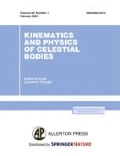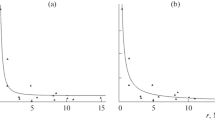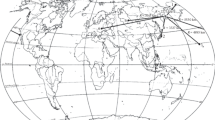Abstract
The purpose of this paper is to construct basic correlation diagrams and plot the respective regression functions for the parameters of the infrasonic signals launched by the Lipetsk meteoroid. The celestial body that entered the Earth’s atmosphere at 01:16:20 UT on June 21, 2018, had the following initial parameters: 14.4 km/s speed, approximately 113 t mass, approximately 4 m size, and approximately 2.8 kt TNT kinetic energy. The infrasonic signals generated by the celestial body were observed on a global scale, and they were recorded by the International Monitoring System (IMS) set up by the Comprehensive Nuclear-Test-Ban Treaty Organization’s International Monitoring System (CTBTO). For data processing, techniques of mathematical statistics have been invoked. The basic results of the study are as follows. The infrasonic signal exhibits a linear dependence of the infrasonic signal time delay on the horizontal distance from the meteoroid explosion epicenter, and the signal celerity averaged over all propagation paths is estimated to be approximately 304–305 m/s. The infrasonic signal celerity first shows a rapid enough decrease with distance, but over the 4.5–8.66-Mm distance range exhibits fluctuations at approximately 302 m/s. The duration of the infrasonic signal shows a linear decrease with distance, and the signal duration dispersion is insignificant in the 5–8 Mm distance range. The mean periods of the infrasonic signal, independent of distance and averaged over various regression functions, are estimated to be 6.28 ± 0.98 s and 6.14 ± 0.76 s. The mean of the initial kinetic energy estimated using the oscillation period of the infrasonic signal is 2.26–2.43 kt TNT, which differs insignificantly from the NASA estimates (2.8 kt TNT). The approximation for the dependence of celerity versus sine of the back-azimuth angle of arrival shows that the corrected value of the celerity is approximately 300 m/s, and the mean of the troposphere-stratosphere wind is approximately 25–31 m/s. Analysis of the correlation diagrams has shown that a steady statistical link exists between the true and observed back-azimuth angles of infrasound sources. It is noted that the level of fluctuations in the azimuth tends to increase with distance.








Similar content being viewed by others
REFERENCES
L. F. Chernogor, “The physical effects of Lipetsk meteoroid. 1,” Kinematics Phys. Celestial Bodies 35, 174–188 (2019).
L. F. Chernogor, “The physical effects of Lipetsk meteoroid. 2,” Kinematics Phys. Celestial Bodies 35, 217–230 (2019).
L. F. Chernogor, “The physical effects of Lipetsk meteoroid. 3,” Kinematics Phys. Celestial Bodies 35, 271–285 (2019).
L. F. Chernogor, “Ionospheric effects of the Lipetsk meteoroid,” Geomagn. Aeron. (Engl. Transl.) 60, 80–89 (2020).
L. F. Chernogor, “Geomagnetic variations caused by the Lipetsk meteoroid’s passage and explosion: Measurement results,” Kinematics Phys. Celestial Bodies 36, 79–93 (2020).
L. F. Chernogor, “Effects of the Lipetsk Meteoroid in the Geomagnetic Field,” Geomagn. Aeron. 60, 355–372 (2020).
L. F. Chernogor and N. B. Shevelev, “Characteristics of the infrasound signal generated by Chelyabinsk celestial body: Global statistics,” Radiofiz. Radioastron. 23, 24–35 (2018).
L. F. Chernogor and N. B. Shevelev, “Parameters of the infrasound signal generated by a meteoroid over Indonesia on October 8, 2009,” Kinematics Phys. Celestial Bodies 34, 147–160 (2018).
Center for Near Earth Object Studies. https://cneos.jpl.nasa.gov/.
T. Ott, E. Drolshagen, D. Koschny, P. Mialle, C. Pilger, J. Vaubaillon, G. Drolshagen, and B. Poppe, “Combination of infrasound signals and complementary data for the analysis of bright fireballs,” Planet. Space Sci. 179, 104715 (2019). https://doi.org/10.1016/j.pss.2019.104715
D. O. ReVelle, “Historical detection of atmospheric impacts by large bolides using acoustic-gravity waves,” Ann. N. Y. Acad. Sci. 822, 284–302 (1997). https://doi.org/10.1111/j.1749-6632.1997.tb48347.x
Funding
The work of L.F. Chernogor and M.N. Shevelev was funded as part of the state budget research activity of institutions of the Ministry of Education and Science of Ukraine, state registration number 0119U002538.
Author information
Authors and Affiliations
Corresponding author
Additional information
Translated by M. Chubarova
About this article
Cite this article
Chernogor, L.F., Shevelev, M. Characteristics of Infrasonic Signals Generated by the Lipetsk Meteoroid: Statistical Analysis. Kinemat. Phys. Celest. Bodies 36, 186–194 (2020). https://doi.org/10.3103/S0884591320040030
Received:
Revised:
Accepted:
Published:
Issue Date:
DOI: https://doi.org/10.3103/S0884591320040030




